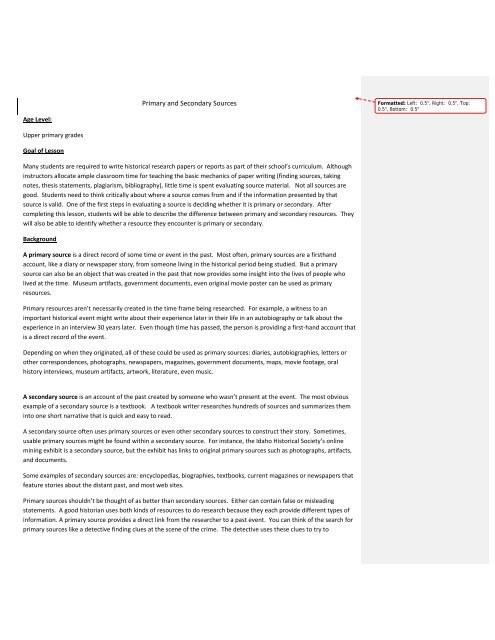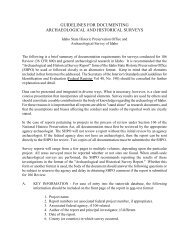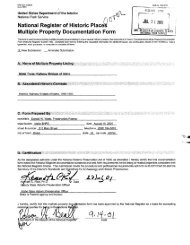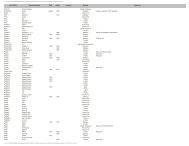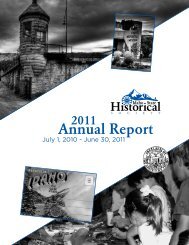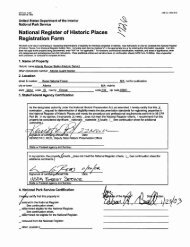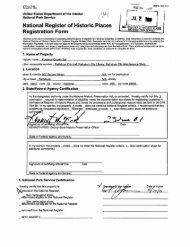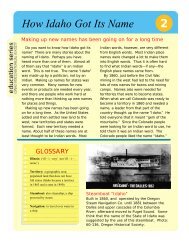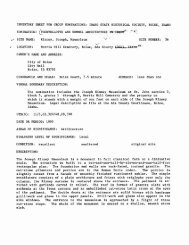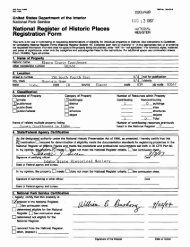Primary and Secondary Sources - Idaho State Historical Society
Primary and Secondary Sources - Idaho State Historical Society
Primary and Secondary Sources - Idaho State Historical Society
- No tags were found...
You also want an ePaper? Increase the reach of your titles
YUMPU automatically turns print PDFs into web optimized ePapers that Google loves.
Age Level:Upper primary gradesGoal of Lesson<strong>Primary</strong> <strong>and</strong> <strong>Secondary</strong> <strong>Sources</strong>Formatted: Left: 0.5", Right: 0.5", Top:0.5", Bottom: 0.5"Many students are required to write historical research papers or reports as part of their school’s curriculum. Althoughinstructors allocate ample classroom time for teaching the basic mechanics of paper writing (finding sources, takingnotes, thesis statements, plagiarism, bibliography), little time is spent evaluating source material. Not all sources aregood. Students need to think critically about where a source comes from <strong>and</strong> if the information presented by thatsource is valid. One of the first steps in evaluating a source is deciding whether it is primary or secondary. Aftercompleting this lesson, students will be able to describe the difference between primary <strong>and</strong> secondary resources. Theywill also be able to identify whether a resource they encounter is primary or secondary.BackgroundA primary source is a direct record of some time or event in the past. Most often, primary sources are a firsth<strong>and</strong>account, like a diary or newspaper story, from someone living in the historical period being studied. But a primarysource can also be an object that was created in the past that now provides some insight into the lives of people wholived at the time. Museum artifacts, government documents, even original movie poster can be used as primaryresources.<strong>Primary</strong> resources aren’t necessarily created in the time frame being researched. For example, a witness to animportant historical event might write about their experience later in their life in an autobiography or talk about theexperience in an interview 30 years later. Even though time has passed, the person is providing a first‐h<strong>and</strong> account thatis a direct record of the event.Depending on when they originated, all of these could be used as primary sources: diaries, autobiographies, letters orother correspondences, photographs, newspapers, magazines, government documents, maps, movie footage, oralhistory interviews, museum artifacts, artwork, literature, even music.A secondary source is an account of the past created by someone who wasn’t present at the event. The most obviousexample of a secondary source is a textbook. A textbook writer researches hundreds of sources <strong>and</strong> summarizes theminto one short narrative that is quick <strong>and</strong> easy to read.A secondary source often uses primary sources or even other secondary sources to construct their story. Sometimes,usable primary sources might be found within a secondary source. For instance, the <strong>Idaho</strong> <strong>Historical</strong> <strong>Society</strong>’s onlinemining exhibit is a secondary source, but the exhibit has links to original primary sources such as photographs, artifacts,<strong>and</strong> documents.Some examples of secondary sources are: encyclopedias, biographies, textbooks, current magazines or newspapers thatfeature stories about the distant past, <strong>and</strong> most web sites.<strong>Primary</strong> sources shouldn’t be thought of as better than secondary sources. Either can contain false or misleadingstatements. A good historian uses both kinds of resources to do research because they each provide different types ofinformation. A primary source provides a direct link from the researcher to a past event. You can think of the search forprimary sources like a detective finding clues at the scene of the crime. The detective uses these clues to try to
econstruct an event <strong>and</strong> guess what really happened. A secondary source, on the other h<strong>and</strong>, can help researcherssummarize a huge amount of information <strong>and</strong> put it into context. This can be very useful when approaching a complextopic for the first time. <strong>Secondary</strong> sources can also provide exciting ideas <strong>and</strong> points‐of‐ view from scholars who havealready examined an issue critically.ActivityAlthough the concept of primary <strong>and</strong> secondary sources is an important one, the presentation of the topic need not becomplex. The lesson has three short parts: definition <strong>and</strong> explanation of the concept by the instructor, independentwork on the <strong>Primary</strong> <strong>and</strong> <strong>Secondary</strong> Source Worksheet, <strong>and</strong> a group review of the answers <strong>and</strong> follow‐up discussion.1. Definition <strong>and</strong> Explanation: Use the background material to present the two types of sources to the class. Itmight be useful to set them up as separate categories on the whiteboard <strong>and</strong> then work as a class to come upwith examples that fit in each column. Make sure that you use a specific hypothetical situation rather thangeneral terms. You might pretend that you are researching baseball from 1900‐1910 or the Lewis <strong>and</strong> ClarkExpedition or some other topic familiar to the students. Some sources can be either primary or secondarydepending on what you are researching. A newspaper article or magazine, for example, could be put in eithercategory depending on when it was written <strong>and</strong> published.2. <strong>Primary</strong> <strong>and</strong> <strong>Secondary</strong> Source Worksheet: After the class has a clear underst<strong>and</strong>ing of the concept, h<strong>and</strong>outthe primary <strong>and</strong> secondary source worksheet <strong>and</strong> have the students work independently to categorize eachsource. The worksheet presents ten imaginary resources that a student might come across while researchingmining in the late 1800’s. The short worksheet will help reinforce the basic concept presented earlier.3. Answer Review <strong>and</strong> Follow‐up Discussion: Go over the answers to the worksheet as a class. If time permits, usethe discussion questions below to facilitate further discussion <strong>and</strong> critical thinking about primary <strong>and</strong> secondaryresources.Possible Discussion QuestionsIs a primary resource better then a secondary resource?Which type of resource is easier to find?Just because a primary source is a first person account does that mean that it is always the truth?Are some sources more reliable than other?How can you tell if a source is reliable?


